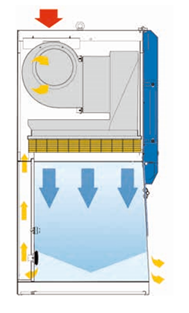 Add My Company
Add My Company

A clean, yet controlled, airflow environment is vital to many scientific applications. Laminar flow hoods (LFH) are essential pieces of equipment in achieving the important levels of purity needed. In a LFH, filtered air circulates in a smooth, unidirectional flow through the workspace.
By maintaining a particle free zone, sensitive products, projects, and processes, along with the LFH operators, are safeguarded from contaminants.
There are two main types of hoods, the vertical LFH (VLFH) and the horizontal LFH (HLFH). Unsurprisingly, the main difference between vertical and horizontal configuration is the direction of the air flow through the hood. Clean air will either flow vertically or horizontally, but what is the benefit to the user?
Vertical LFHs have a pre-filter positioned at the top, pushing the environmental air down toward the work bench filter through H14HEPA filters with the directed filtered air then pushed vertically out of the front panel. About half of volume is exhausted outside into the environment while the remaining air is recirculated by the means of the slots positioned at the bottom of the back panel, as shown in figure 1.
VLFH is useful if there is the need to maintain low contamination level while using large bulky equipment. It is also useful for applications using powders; the vertical configuration prevents material being blown directly towards the user.
In a horizontal LFH, the filters are fixed to the back of the wall of the unit, with ambient air drawn in from the top via the upper part of the cabinet, through a pre-filter which is then passed through a H14HEPA filter into the working area of the HLFH and onward exhausted out through the front opening, as illustrated in figure 2.
HLFHs are best advised for simple workspace based experiments that do not use hazardous materials but where contamination prevention is still a priority; such as tissue culturing, media plating and small electronic inspections.
When deciding between a VLFH or HLFH options, the nature of the work to be carried out in them should be considered along with the specific requirements of the process and experiments. Both variations will maintain a clean filtered environment in which one can conduct sensitive procedures. However, there are subtle distinctions between the two types of hoods which will determine the right LFH configuration for you.
At Biopharma Group, we pride ourselves on our expertise in airflow technology. Our close partnership with Faster s.r.l. makes us ideally placed to provide reliable advice and solutions, no matter the complexity of the task at hand. Our commitment extends to helping you make informed decisions, and success across projects.
For more information and to explore our range of laminar flow hoods, contact us via www.fasterair.co.uk


At Biopharma Group, we pride ourselves on our expertise in airflow technology. Our close partnership with Faster s.r.l. makes us ideally placed to provide reliable advice and solutions, no matter the complexity of the task at hand. Our commitment extends to helping you make informed decisions, and success across projects.
For more information and to explore our range of laminar flow hoods, contact us via www.fasterair.co.uk
For more information on Differences Between Horizontal and Vertical Laminar Flow Hoods talk to Biopharma Group

